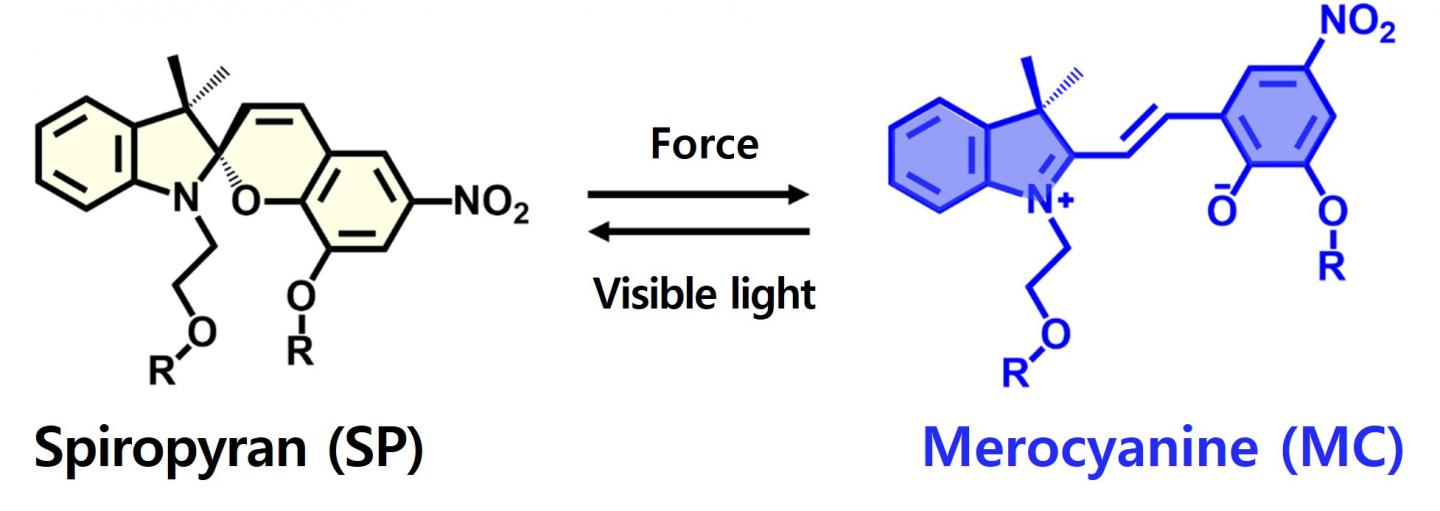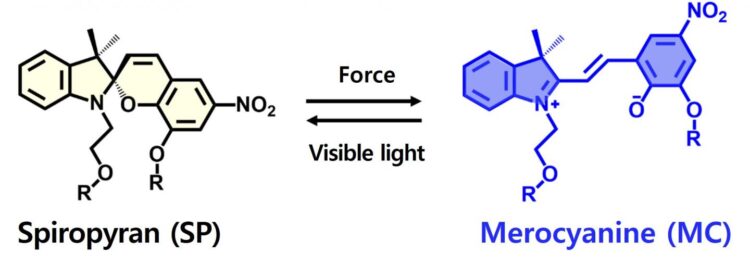Development of a next-generation mechano-sensitive material where parts requiring repair can be distinguished by color. 850% improved sensitivity compared to existing materials.

Credit: Korea Institue of Science and Technology(KIST)
Human skin bruises when the tissue and muscle in the area suffer trauma or become damaged due to an application of blunt force. However, when an object suffers an impact that is expected to damage, it is necessary to examine every inch of the surface of the material to understand the extent of the damaged. In the case of an airplane, for example, it is fully inspected to ensure safety. If the areas damaged by a physical impact undergo a change in color, just like human skin, it will be easy to distinguish what needs to be repaired.
Spiropyran, a molecule that reacts to external force, changes color when it is physically stimulated due to a change in its chemical structure. When this substance is injected in concrete or silicone, it reacts to mechanical stimuli such as force, deformation and damage by changing color. However, the mechano-sensitivity of such composite material is too low for real-life applications. When applied to silicone, for example, the color changes only after deformation of at least 500%.
A research team headed by Dr. Jaewoo Kim from the Structural Composite Research Center at the Institute of Advanced Composite Materials of the Korea Institute of Science and Technology (KIST) has drastically improved the mechano-sensitivity for the material to be applicable to wearable sensors and artificial skin.
In order to enhance sensitivity, previous studies have applied a method of modifying the molecular structure of spiropyran according to the material it would be combined with prior to synthesis. In contrast, the KIST researchers synthesized the composite material first and then added a certain type of solvent to improve the sensitivity through a sort of aging process. Then, the changes in the color and fluorescence of the composite material were observed, while controlling the absorption time with the solvent, and it was found that increasing the treatment time improved the sensitivity. The spiropyran-polymer developed through this new process showed 850% improvement in sensitivity compared to the previously developed materials. Such remarkable sensitivity was seen for various types of deformations such as tension, compression and bending.
Also, unlike the existing method of improving sensitivity by manipulating each material separately, the new method developed through this study that increases sensitivity simply with an aging process using a solvent presents advantages in that it can be easily applied to various materials.
Dr. Jaewoo Kim from KIST said, “Through this study, a process that can dramatically improve the mechano-sensitivity of spiropyran-based stress-sensitive smart polymer materials has been developed, and through analysis, the mechanism behind sensitivity improvement was identified. […] Based on this, we plan to devote ourselves to a follow-up study in which we apply the technology to futuristic wearable sensors and artificial skin.”
###
This research was carried out through major projects of KIST with the support of the Ministry of Science and ICT (MSIT), and the research results were published in the latest issue of the international academic journal Macromolecules (IF:5.918, the top 7.303% in the JCR field).
Glossary description:
* Spiropyran: A molecular sensor in which the chemical structure is converted into merocyanine (MC) in response to mechanical force, along with changes in the color and fluorescence properties
Notes to editors:
This study was conducted with a grant from the Ministry of Science and ICT (Minister Ki-young Choi), as part of the Institutional R&D Program of KIST. The related paper was published in the latest edition of the international journal, Macromolecules (IF: 5.918, Top 7.303% in the field of JCR).
Media Contact
Do-Hyun Kim
[email protected]
Related Journal Article
http://dx.





